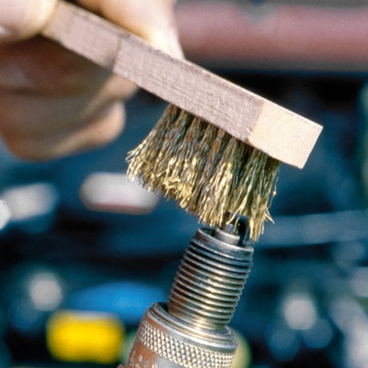A comprehensive guide to 2- stroke engine maintenance.
The Complete Guide to 2-stroke Engine Maintenance
–
by the Real Experts in Agricultural and Gardening Engines
2-stroke fuel-oil mix engines are endothermic engines, i.e. internal combustion engines that require air and a petrol and lubricating oil mix specifically for 2-stroke engines to operate.
1. Lubricating oil
Unlike 4-stroke engines, which have separate lubrication and contain oil in a separate sump at the bottom of the engine block, where the oil is fed in separately and replaced at calculated intervals, 2-stroke engines are completely oil-free (indeed, there is no oil filler cap inside them).

In order to operate, these engines must be filled with a mixture of petrol and specific oil.
The oil is injected directly with the fuel, which is then used for a dual function, both for combustion (to produce energy through the rotation of the crankshaft) and to lubricate the engine with the direct supply of that percentage of oil in the mix.
The percentage of oil to be mixed with petrol may vary according to the manufacturer’s specifications or the machine’s intensity of use.
When running, this type of engine burns oil in addition to petrol and is therefore smokier than a 4-stroke engine. Not surprisingly, the latter is less polluting and more comfortable for the user, who can thus work in a cleaner environment with fewer exhaust gases.
However, while it is certainly true that the 2-stroke engine, compared to the bursts of the 4-stroke engine (which are twice as high at the same number of revolutions), has a higher consumption, it also has four considerable advantages:
- more power than the 4-stroke engine (with the same displacement);
- a higher torque than a 4-stroke engine;
- can work in any position;
- a much smaller size and, above all, a much lower weight than a 4-stroke engine of similar power.
It is precisely for these reasons that much of the equipment requiring compact dimensions and portability by the operator is built with a 2-stroke fuel-oil mix engine, as it is not possible to obtain the same level of lightness and comfort from a 4-stroke engine of similar power. Despite this, new 4-stroke engines have been launched on the market and offer certain advantages, such as the ability to work in all positions, the significantly reduced weight compared to previous models (so much so that they are fitted on brush cutters) and other advantages over petrol engines.
Despite the great success of these machines (mainly Honda branded, being the reference manufacturer of these engines), they are a little heavier, a little less powerful and have less torque than 2-stroke ones.
Therefore, for intensive working sessions or even professional use, it is strongly recommended to choose a 2-stroke engine.
Some examples of portable equipment made with a 2-stroke fuel-oil mix engine:

For the same reason, all equipment that ‘works on the ground’, i.e. does not need to be lifted manually from the ground to operate, regardless of whether it is hand-pushed or self-propelled, is usually fitted with a 4-stroke engine.
A few examples of portable equipment made with a 4-stroke petrol engine:
- Riding-on Mowers
- Lawn Mowers
- Scythe Mowers
- Snow Blowers
- Garden Shredders
- Tracked Power Barrows
- Garden Tillers
- Generators

In 2-stroke engines, the quality of the oil is fundamental, both to establish the right mixing percentage and to safeguard the durability and correct lubrication of the engine, which is essential to avoid galling. The best oil now being sold and used is synthetic oil, which provides a better level of engine protection and less pollution.
As the name imply, this type of oil has a high synthetic component, which determines its quality: the higher the synthetic part, the higher the quality, and therefore the lubricating capacity of the oil.
Mineral oil (obtained directly from the refining of petroleum) should be fed in twice as much, typically 4% or 5%, as synthetic oil (obtained from the chemical synthesis of petroleum), typically 2% or 3%.
The best thing to do is to follow the instructions in the user’s manual of the machine.
Thanks to this lower percentage, not only it is possible to achieve the same or better performance of both the engine and the lubrication, but it also contributes to less fouling on the piston and spark plug. It also reduces the risk of compromising those parts of the carburettor that usually become dirty or clogged due to small residues in the canister or the amount of old oil sticking to the membranes and clogging one of the mini-pipes.
2. Air filter
One of the elements of an engine that should not be overlooked is the air filter.
Easy to reach and check, the air filter requires very simple routine maintenance: simply blow away the dust with an air compressor.

3. Spark plug
For maximum combustion, spark plugs should be checked at least once a year.
As they have a long service life, they do not need to be replaced, but they do require constant checks to ensure that they are in good condition.
Check the distance between the spark plug electrodes and adjust them, if necessary, according to the instructions in the owner’s manual.
A clean spark plug guarantees good combustion and thus optimum engine operation.
To remove oil residues and dirt from the housings, it is sufficient to use a powerful jet of compressed air and a cloth, while a simple metal brush is sufficient to clean spark plug threads.
4. Fuel
Before long periods of inactivity (more than 2 months), do not leave fuel in the tank. Petrol tends to separate from the oil and lose its original characteristics, which can affect engine operation and even cause galling. In some cases, the carburettor may also be damaged to such an extent that expensive maintenance is required.
Once the tank has been emptied, start the engine and leave it running to use up all the fuel until it is switched off.
5. Problems and solutions
| Problem | Cause | Solution | ||
|---|---|---|---|---|
| Engine | -difficult start-up -start-up failure | |||
| Engine running | Fuel in the cylinder | No fuel in the cylinder | -Clogged fuel filter -Clogged fuel hose -Carburetor | -Clean or replace -Clean -Contact your dealer |
| Fuel in the cylinder | No fuel in the cylinder | Carburettor | Contact your dealer | |
| Fuel-soaked muffler | Fuel-oil mix too rich | Open air valve -Clean/replace air filter -Adjust carburettor -Contact your dealer | ||
| Spark at the end of the spark plug wire | No spark at the end of the spark plug wire | -Ignition switch on OFF -Electrical problem | ||
| Spark on spark plug | No spark on the spark plug | Incorrect spark plug electrode distance -Carbon fouling -Fuel leakage -Defective spark plug | -Adjust according to manual -Clean or replace -Replace spark plug | |
| The engine does not start | Internal engine problem | Contact your dealer | ||
*ATTENTION!*
The advice given in this guide for the maintenance of 2-stroke engines DOES NOT REPLACE the periodic ordinary and extraordinary checks and maintenance provided for in the manufacturer’s manual.




